This set of Electrical Machines Multiple Choice Questions & Answers (MCQs) focuses on “Transformer Losses and Efficiency”.
1. Which of the statements made here are correct regarding the transformer?
I. Maximum voltage regulation occurs at the leading p.f. II. Maximum voltage regulation occurs when load p.f. angle and impedance angle of the leakage impedance are same. III. V.R. at zero p.f. is always zero. IV. V.R. of a transformer may be negative at leading p.f.
a) I, III
b) II, IV
c) 1, III
d) I, IV, III
View Answer
Explanation: V.R. is always negative at leading p.f. and the load p.f. angle and impedance angle of the leakage impedance should be same for maximum V.R.
2. Which of the statements made here are correct regarding the transformer?
I. Maximum voltage regulation occurs at the leading p.f. II. Maximum voltage regulation occurs when load p.f. angle and impedance angle of the leakage impedance are same. III. V.R. at zero p.f. is always zero. IV. V.R. of a transformer may be negative at leading p.f.
a) I, II, III
b) II, IV
c) 1, III
d) I, IV, III
View Answer
Explanation: V.R. is always negative at leading p.f. and the load p.f. angle.
3. Which of the statements made here are incorrect regarding the transformer?
I. Maximum voltage regulation occurs at the leading p.f. II. Maximum voltage regulation occurs when load p.f. angle and impedance angle of the leakage impedance are same. III. V.R. at zero p.f. is always zero. IV. V.R. of a transformer may be negative at leading p.f.
a) I,III
b) II,IV
c) 1,III
d) I,IV,III
View Answer
Explanation: V.R. is always negative at leading p.f. and the load p.f. angle and impedance angle of the leakage impedance should be same for maximum V.R.
4. Which of the statements made here are incorrect regarding the transformer?
I. Maximum voltage regulation occurs at the leading p.f. II. Maximum voltage regulation occurs when load p.f. angle and impedance angle of the leakage impedance are same. III. V.R. at zero p.f. is always zero. IV. V.R. of a transformer may be negative at leading p.f.
a) I,II,III
b) IV
c) 1,III
d) I,IV,III
View Answer
Explanation: V.R. is always negative at leading p.f. and the load p.f. angle.
5. Which of the following mentioned losses occur in a transformer?
a) Hysteresis losses; Eddy current losses; Dielectric losses; Stray load losses
b) Hysteresis losses; Eddy current losses;
c) Dielectric losses; Stray load losses
d) Hysteresis losses; Eddy current losses; Stray load losses
View Answer
Explanation: Hysteresis losses-due to magnetic material; Eddy current losses-on the core area; Dielectric losses- due to insulation material; Stray load losses- due to leakage through the parts of the transformer.
6. Mutual flux ______ at the lagging loading and it _____ at the leading power factor.
a) decreases, increases
b) increases, increases
c) decreases, decreases
d) increases, decreases
View Answer
Explanation: The mutual flux falls when the transformer is working at lagging p.f. and it increases at leading p.f.
7. It is possible to attain maximum efficiency in a transformer when the ______
a) core losses are equal to rated full load copper losses
b) core losses are more than rated full load copper losses
c) core losses and full load copper losses are constant
d) copper loss also becomes constant
View Answer
Explanation: Maximum efficiency is achieved at the condition when fixed core losses and copper losses at rated condition are equal.
8. The efficiency of a 20 KVA, 2000/200 V, single phase transformer at unity pf is 98%. The total losses at this condition is?
a) 408W
b) 4.08kW
c) 204W
d) 2.04kW
View Answer
Explanation: Efficiency = 1-(losses/input) = 1-(losses/output+losses)
0.98 = 1-(Losses/20000+losses)
Losses = 408 W.
9. The efficiency of a 20 KVA, 2000/200 V, single phase transformer at unity pf is 98%. The given total losses at full load is 200 W. The pu resistance is?
a) 0.01
b) 0.1
c) 1.0
d) 0.0196
View Answer
Explanation: pu resistance = Ohmic losses/KVA = 200/20000 = 0.01 pu.
10. The load current at which maximum efficiency occurs is independent of the load power factor.
a) True
b) False
View Answer
Explanation: Because Core losses and the effective resistance of the secondary are almost unaffected by load p.f.
11. The full load voltage drop in a 1-phase transformer is 2% and 4% respectively due to resistance and leakage reactance. Then the voltage drop is maximum at __________
a) 0.45 lagging
b) 0.45 leading
c) 0.9 lagging
d) 0.9 leading
View Answer
Explanation: Z = 4.47; cosθ = percentage r/percentage z = 2/(4.47) = 0.45.
12. The full load voltage drop in a 1-phase transformer is 2% and 4% respectively due to resistance and leakage reactance. Then the voltage drop is zero at __________
a) 0.45 lagging
b) 0.45 leading
c) 0.9 lagging
d) 0.9 leading
View Answer
Explanation: Z = 4.47; cosθ = percentage x/percentage z = 4/4.47 = 0.89.
13. Core losses of a transformer as a function of frequency is best approximated by which of the below characteristics?
a) 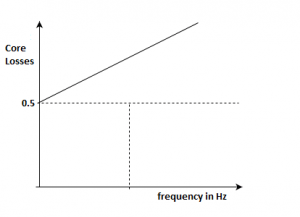
b)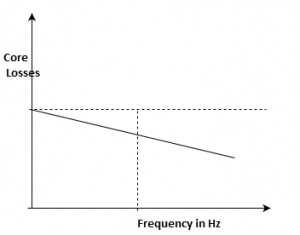
c)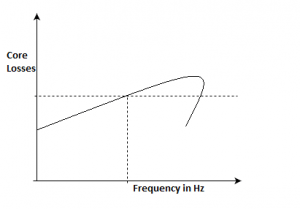
d)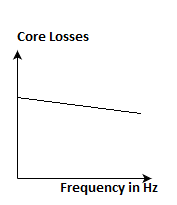
View Answer
Explanation: We can represent the core losses per cycle eq. as Pc/f = A+B*f, where A and B are constants.
14. From the above graph of the core losses per cycle is, the hysteresis losses per phase for a transformer at a operating frequency of 40 Hz is?
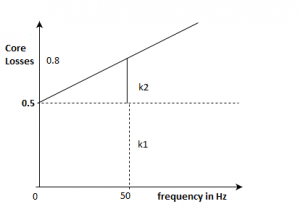
a) 20W
b) 30W
c) 80W
d) 32W
View Answer
Explanation: Ph = k1*f = 0.5*40 = 20W.
15. From the above graph of the core losses per cycle is, the eddy losses per phase for a transformer at a operating frequency of 40 Hz is?

a) 15 W
b) 20W
c) 35W
d) 32W
View Answer
Explanation: Pe = k2*f2;
Using the slope of the line, (k2)*50 = 0.8 – 0.5 = 0.3
(k2) = 0.006
Pe = 50*50*0.006 = 15 W.
16. The efficiency of a transformer can be calculated accurately from ___________
a) Open circuit test, Short circuit test
b) Open circuit test, Short circuit test, Sumpner’s test
c) Sumpner’s test
d) load test
View Answer
Explanation: OC and SC tests together can help to estimate the most correct value of the efficiency for the given transformer.
Sanfoundry Global Education & Learning Series – Electrical Machines.
To practice all areas of Electrical Machines, here is complete set of 1000+ Multiple Choice Questions and Answers.
If you find a mistake in question / option / answer, kindly take a screenshot and email to [email protected]
- Practice Electrical & Electronics Engineering MCQs
- Apply for Electrical Engineering Internship
- Check Electrical Engineering Books
- Apply for Electrical & Electronics Engineering Internship
- Practice Electrical Engineering MCQs
